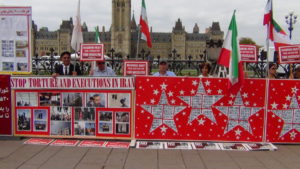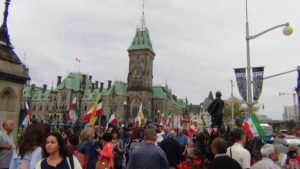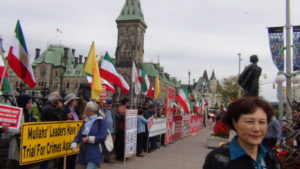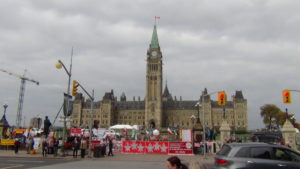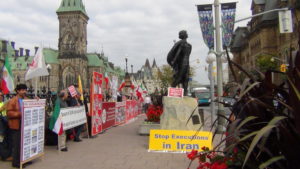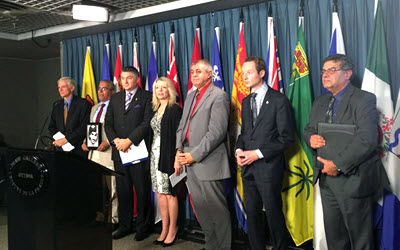
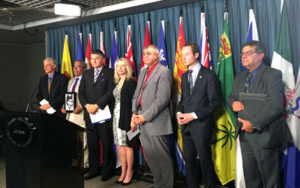 In a press conference at the Canadian Parliament on October 6, Members of Parliament, representative of the Iranian-Canadian community, and eyewitnesses to the 1988 massacre urged the government of Canada to implement a motion adopted by parliament in 2013. That document condemned the massacre of political prisoners and expressed solidarity with political prisoners being held in Iranian jails today. Also, ever since 2003, Canada has sponsored an annual United Nations resolution denouncing Iran’s ongoing human rights violations. The October 6 press conference urged the Canadian government to mention the 1988 massacre in this year’s resolution.
In a press conference at the Canadian Parliament on October 6, Members of Parliament, representative of the Iranian-Canadian community, and eyewitnesses to the 1988 massacre urged the government of Canada to implement a motion adopted by parliament in 2013. That document condemned the massacre of political prisoners and expressed solidarity with political prisoners being held in Iranian jails today. Also, ever since 2003, Canada has sponsored an annual United Nations resolution denouncing Iran’s ongoing human rights violations. The October 6 press conference urged the Canadian government to mention the 1988 massacre in this year’s resolution.
Speaking at the House of Commons, the speakers called on the Canadian government to play a leading role in demanding a UN commission of inquiry on this crime against humanity, thereby sending a clear message that Iran faces consequences for human rights abuses.
In the summer of 1988, based on a fatwa decreed by the Islamic Republic’s founder Ayatollah Khomeini, some 30,000 political prisoners were massacred in the space of a few months and buried secretly in mass graves. The overwhelming majority of them were affiliated with the People’s Mojahedin Organization of Iran, which remains the principal opposition movement to this day.
In August 2016 an audio file surfaced of Khomeini’s then-heir as the supreme leader Ayatollah Hossein-Ali Montazeri speaking about the massacre, which triggered a crisis in Tehran. In the recording, dated August 15, 1988, Montazeri can be heard harshly criticizing members of Tehran’s “Death Commission” who were appointed by Khomeini.
Shahram Golestaneh, spokesman for the Iran Democratic Association provided new details about dozens of officials involved in the massacre and some secret mass graves where they were buried.
According to Golestaneh “Scores of the officials who were responsible for this crime against humanity are at the helm of important Iranian institutions. According to the report of the UN Secretary General in September, nearly 1,000 executions were reported in Iran in 2015, the highest in the past two decades. The very same individuals who carried the 1988 massacre are continuing their crimes with impunity.”
He added: “According to information compiled by the National Council of Resistance of Iran (NCRI) from sources inside Iran, most of the institutions of the Iranian regime are run by the perpetrators of the 1988 massacre. In recent weeks, about 60 of the most senior officials responsible for this massacre, whose names had remained secret for nearly three decades have been identified. These individuals were members of the “Death Commissions” in Tehran and 10 other Iranian provinces.”
Golestaneh disclosed the details of eight mass graves which have never been revealed before. These mass graves are in Mashhad (north-east Iran), Zanjan (north-west Iran), Kermanshah (western Iran), Sume’e Sara (northern Iran), Tonekabon (northern Iran- two new mass graves were found there), Dezful (south-west Iran), and Bandar-e Gaz (northern Iran).
Candice Bergen, Canada’s former Minister of State and Conservative MP pointed out the appalling human rights situation in Iran, particularly repression of women, as described in the recent report of the UN Secretary General. She dismissed the notion of possible moderation under Iranian President Hassan Rouhani and said that the very same officials who are responsible for modern-day repressive measures were implicated in the 1988 massacre and represent both the hardline and “moderate” faction of the regime. She joined her colleagues in asking the Canadian government to implement the 2013 motion and to ask for a UN investigation.
Michael Cooper, a Member of Parliament from Edmonton, reiterated that the Iranian regime executed children as young as 15 in the massacre of 1988. He stated that he stood with the Iranian Canadian community in commemorating 30,000 political prisoners mass murdered in 1988. He elaborated on the role of the Iranian regime in fighting in Syria, human rights abuses inside Iran, and funding terrorist groups such as Hezbollah. He said that if the massacre of 1988 taught us anything, it is that the Iranian regime is anything but normal.
James Bezan, an influential voice in the Canadian Parliament on Iran human rights, used the press conference to praise the 2013 motion adopted by parliament. Bezan called for an end to impunity and urged the Canadian government to implement the motion and ask the UN to conduct an inquiry into this hideous crime.
David Kilgour, Chairman of Canadian Friends of a Democratic Iran pointed out the leading role that Canada can play in the human rights field. He cited the example of South Africa under Apartheid, when Canada led the way to change the status quo. As a former lawyer, he stated that impunity should come to an end and Canada should stand up for accountability and the rule of law in the case of this crime against humanity.
Mr. Ahmad Hassani gave an account of his brother, Mahmoud Hassani’s execution as part of 30,000 political prisoners mass murdered in 1988. He said to date, the regime has not provided any details about where his body was buried. Mr. Mehdi Garmroudi, who also lost his brother in the massacre of 1988, provided his own eyewitness account.












